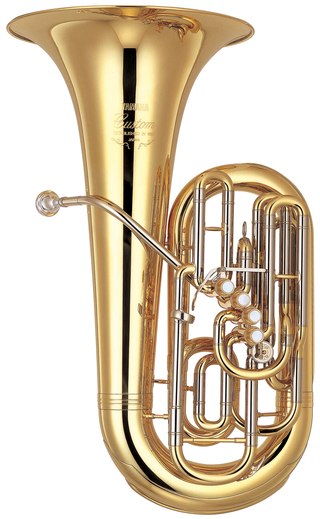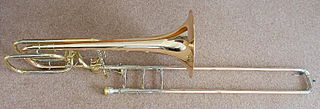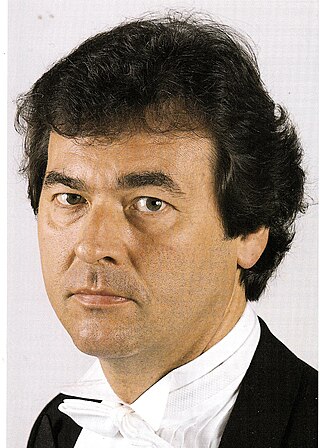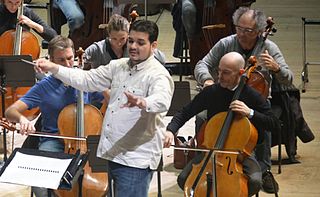
The euphonium is a medium-sized, 3 or 4-valve, often compensating, conical-bore, tenor-voiced brass instrument that derives its name from the Ancient Greek word εὔφωνος euphōnos, meaning "well-sounding" or "sweet-voiced". The euphonium is a valved instrument. Nearly all current models have piston valves, though some models with rotary valves do exist.

The trombone is a musical instrument in the brass family. As with all brass instruments, sound is produced when the player's vibrating lips cause the air column inside the instrument to vibrate. Nearly all trombones use a telescoping slide mechanism to alter the pitch instead of the valves used by other brass instruments. The valve trombone is an exception, using three valves similar to those on a trumpet, and the superbone has valves and a slide.

The tuba is the largest and lowest-pitched musical instrument in the brass family. As with all brass instruments, the sound is produced by lip vibration – a buzz – into a mouthpiece. It first appeared in the mid-19th century, making it one of the newer instruments in the modern orchestra and concert band, and largely replaced the ophicleide. Tuba is Latin for "trumpet".
Simon Proctor is a British composer and pianist, known for his works for unusual instruments.

The serpent is a low-pitched early wind instrument in the brass family developed in the Renaissance era. It has a trombone-like mouthpiece, with tone holes and fingering like a woodwind instrument. It is named for its long, conical bore bent into a snakelike shape, and unlike most brass instruments is made from wood with an outer covering of leather. A distant ancestor of the tuba, the serpent is related to the cornett and was used for bass parts from the 17th to the early 19th centuries.

The cimbasso is a low brass instrument that covers the same range as a tuba or contrabass trombone. First appearing in Italy in the early 19th century as an upright serpent, the term cimbasso came to denote several instruments that could play the lowest brass part in 19th century Italian opera orchestras. The modern cimbasso design, first appearing as the trombone basso Verdi in the 1880s, has four to six rotary valves, a forward-facing bell, and a predominantly cylindrical bore. These features lend its sound to the bass of the trombone family rather than the tuba, and its valves allow for more agility than a contrabass trombone. Like the modern contrabass trombone, it is most often pitched in F, although models are occasionally made in E♭ and low C or B♭.

Denis Wick is an influential British orchestral trombonist. He is also an internationally respected brass teacher and designer of brass mutes and mouthpieces. On retirement in 1989 he was awarded the International Trombone Association's annual award; he served as their president 2004–2006.

The bass trombone is the bass instrument in the trombone family of brass instruments. Modern instruments are pitched in the same B♭ as the tenor trombone but with a larger bore, bell and mouthpiece to facilitate low register playing, and usually two valves to fill in the missing range immediately above the pedal tones.

The ophicleide is a family of conical-bore keyed brass instruments invented in early 19th-century France to extend the keyed bugle into the alto, bass and contrabass ranges. Of these, the bass ophicleide in C or B♭ took root over the course of the 19th century in military bands and as the bass of orchestral brass sections throughout Western Europe, replacing the serpent and its later upright derivatives. By the end of the 19th century however, it had been largely superseded by early forms of the modern tuba, developed from valved ophicleides.

The alto trombone is the alto member of the trombone family of brass instruments, smaller than the tenor trombone. It is almost always pitched in E♭ a fourth higher than the tenor, although examples pitched in F are occasionally found. The alto trombone was commonly used from the 16th to the 18th centuries in church music to strengthen the alto voice, particularly in the Mass. Alto trombone parts are usually notated in alto clef.
Kenneth Amis is a Bermudian tuba player and composer best known for his association with the Empire Brass. He is also the assistant conductor of the MIT Wind Ensemble, a group he has been involved with since its creation in 1999. In addition, as of 2005, Amis is an Affiliated Artist of MIT.

Emory Brace Remington (1892–1971) was a trombonist and music teacher. His unique method made him one of the most well-known and influential trombone educators in history. He was a member of the Rochester Philharmonic Orchestra from 1923 to 1949, and on the faculty of the Eastman School of Music in Rochester, NY from 1922 until his death in 1971.

The contrabass trombone is the lowest-pitched instrument in the trombone family of brass instruments. While modern instruments are pitched in 12 ft F with a single slide, the first practical contrabass trombones appeared in the mid-19th century built in 18′ B♭ an octave below the tenor trombone with a double slide. German opera composer Richard Wagner notably called for this instrument in his Der Ring des Nibelungen opera cycle in the 1870s, and contrabass trombone has since appeared occasionally in large orchestral works without becoming a permanent member of the modern orchestra.

Raymond Eugene Premru was an American trombonist, composer, and teacher who spent most of his career in London, England.
Tyrone Breuninger was an American trombonist with the Philadelphia Orchestra as well as a euphonium/trombone/tuba teacher from Rowan University, located in Glassboro, New Jersey. Throughout his career, he also did freelance solo performances. His degrees include a Bachelor of Science in music education and an MM of music in performance. He also arranged a version of Georg Philipp Telemann's Sonata in G minor for euphonium.
Gary Alan Kulesha is a Canadian composer, pianist, conductor, and educator. Since 1995, he has been Composer Advisor to the Toronto Symphony Orchestra. He has been Composer-in-Residence with the Kitchener-Waterloo Symphony (1988–1992) and the Canadian Opera Company (1993–1995). He was awarded the National Arts Centre Orchestra Composer Award in 2002.

Peter Bassano is an English conductor.
Kerry Turner is an American composer and horn player. Turner is a recognized name in the horn and brass industry. Turner’s major ensembles with whom he performs include the American Horn Quartet, the Virtuoso Horn Duo, and the Luxembourg Philharmonic Orchestra. Turner has performed internationally as a soloist and clinician. Turner also sings tenor in a semi-professional octet.

Giancarlo Castro D'Addona is a Venezuelan - Italian composer, conductor and trumpet player. Gold medal winner at the Global Music Awards in San Diego - California (US).
Igor Krivokapič is a Slovenian composer, retired tubist and instrument inventor.














